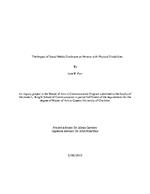|
|

Notes
- Abstract:
- 38.5 million people in the United States are identified as persons with physical disabilities. Persons with physical disabilities often face isolation from the general population in face-to-face settings resulting in limited opportunities to form relationships (Thoreau, 2006), due to an ongoing disability narrative that suggests this group has qualities that are not worthy of belonging among the non-disabled resulting in limited opportunities to form relationships (Thoreau, 2006). Social media has offered new opportunities for persons with disabilities to form relationships. Evidence of a safe user experience for persons with disabilities looking to disclose personal information about their disability on social media is difficult to find. This qualitative study establishes a theoretical framework to understand how, when, and why persons with physical disabilities choose to disclose his or her disability on social media platforms, and what rewards and challenges are encountered when sharing their disability disclosure on social media. Major findings from the study describe (1) three distinct approaches for disability disclosure, (2) the roles of age of discloser and age of the disability as key factors in approach selection, and (3) four incentives, which serve as driving factors for disability disclosure. ( en )
Postcard Information
- Format:
- Thesis
|
|